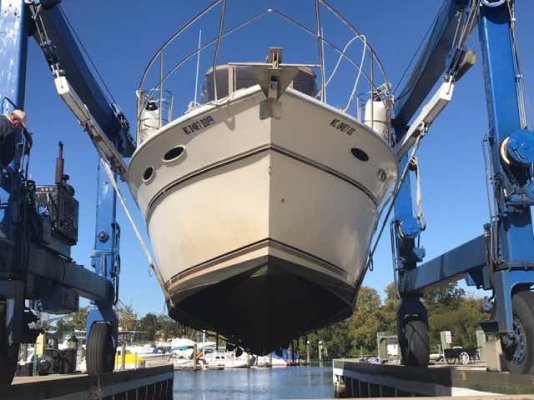You are using an out of date browser. It may not display this or other websites correctly.
You should upgrade or use an alternative browser.
You should upgrade or use an alternative browser.
Slurry Blasting
- Thread starter ChesapeakeGem
- Start date
The friendliest place on the web for anyone who enjoys boating.
If you have answers, please help by responding to the unanswered posts.
If you have answers, please help by responding to the unanswered posts.
MichaelB1969
Guru
- Joined
- Oct 15, 2016
- Messages
- 679
- Location
- USA
- Vessel Name
- Speedy Charlotte
- Vessel Make
- Beneteau Swift Trawler 44
Purchased in April of this year, knowing we have blisters. She's on the hard getting a bottom blasting next week. Going to let her sit and seep for the winter... then the work begins.
1983 36' Sea Ray aft cabin.
Congrats on the purchase!
ChesapeakeGem
Senior Member
Congrats on the purchase!
Thank you!
Have had some wonderful times!
CaptSteve53
Senior Member
Purchased in April of this year, knowing we have blisters. She's on the hard getting a bottom blasting next week. Going to let her sit and seep for the winter... then the work begins. View attachment 68598
1983 36' Sea Ray aft cabin.
I'm supposing your mention of Slurry blasting is to remove the gel coat(if you are doing a complete new Epoxy bottom Job?) if not then a gel stripper or similar will need to remove the gel coat as other wise as others have pointed out it will not dry out sufficiently (especially in Winter conditions),
If only spot replacement not such an issue at all,
If drying out vessels here in our wet season we "BAG"the hull using plastic sheeting and make a tent like structure fully enclosing the hull (and yes the ground it's self) then we place inside several de-humidifiers, this works well but still takes several months to get the hull under under 5% min , de humidifiers inside the vessel is also a good idea with floors removed,
Cheers Steve
CaptSteve53
Senior Member
Steve. When we dry out flooded structures, use the same approach, with the addition of heat to attain 95-100F interior temp to accelerate the process. Same with hull drying?
Yep, any additional interior heating will obviously help, here even in wet season it's pretty hot so getting rid of the moisture is the big thing, obviously the bilges and tanks (if built in as a part of the hull) need to be dry as well,
Its good to use blow type heaters (fans) as it helps circulating the warm air, if using de-humidifiers make sure they are emptied daily (most have internal tanks) and fill quite quickly, or run an external hose to the outside. Other wise even light bulbs give off an amazing amount of heat and at least they are safe to leave un attended (can be an issue when using heaters),
If you dont have one, a good moisture meter is a primary requirement prior to any laminating,
Are you doing the whole hull? or just spots?
Cheers Steve
sbu22
Guru
- Joined
- Mar 16, 2011
- Messages
- 1,253
- Location
- US
- Vessel Name
- Panache
- Vessel Make
- Viking 43 Double Cabin '76
Good point - air circulation and lots of it is essential to the effective functioning of DHs.
We never allow the heat source interior to the enclosure for safety/property damage considerations. Heat source external and heated air ducted in.
We never allow the heat source interior to the enclosure for safety/property damage considerations. Heat source external and heated air ducted in.
ChesapeakeGem
Senior Member
Unless you grind off or shave off the gel coat and get to dry glass, or apply heat blankets and suction, a winter will not necessarily dry a bottom well enough for a new bottom.
Thank you we will keep that in mind
Similar threads
- Replies
- 18
- Views
- 2K
- Replies
- 0
- Views
- 352

